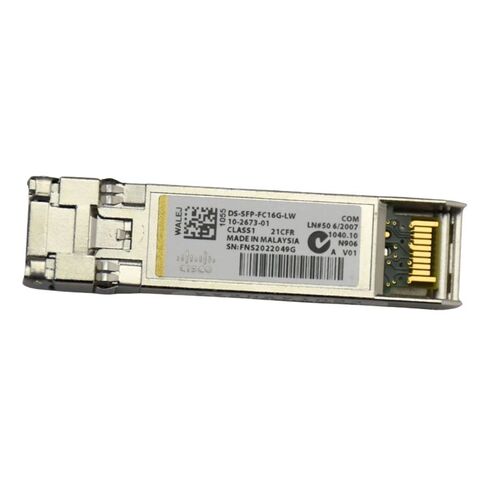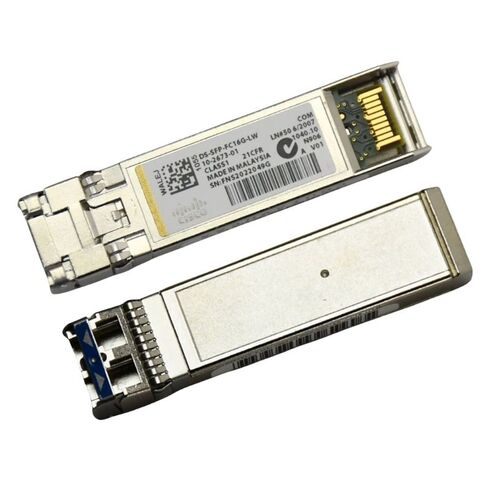DS-SFP-FC16G-LW Cisco SFP+ Transceiver Module Fibre Channel
- — Free Ground Shipping
- — Min. 6-month Replacement Warranty
- — Genuine/Authentic Products
- — Easy Return and Exchange
- — Different Payment Methods
- — Best Price
- — We Guarantee Price Matching
- — Tax-Exempt Facilities
- — 24/7 Live Chat, Phone Support
- — Visa, MasterCard, Discover, and Amex
- — JCB, Diners Club, UnionPay
- — PayPal, ACH/Bank Transfer (11% Off)
- — Apple Pay, Amazon Pay, Google Pay
- — Buy Now, Pay Later - Affirm, Afterpay
- — GOV/EDU/Institutions PO's Accepted
- — Invoices
- — Deliver Anywhere
- — Express Delivery in the USA and Worldwide
- — Ship to -APO -FPO
- — For USA - Free Ground Shipping
- — Worldwide - from $30
Same product also available in:
| SKU/MPN | Warranty | Price | Condition | You save |
|---|---|---|---|---|
| DS-SFP-FC16G-LW | 1 Year Warranty | $52.00 | Excellent Refurbished | You save: $18.20 (26%) |
| DS-SFP-FC16G-LW | 1 Year Warranty | $109.00 | Factory-Sealed New in Original Box (FSB) | You save: $38.15 (26%) |
Overview of Cisco 16GBPS Transceiver
- Brand: Cisco
- Part Number: DS-SFP-FC16G-LW
- Type: SFP+ transceiver module
Technical Specifications
Form Factor
Plug-in module design for seamless integration.
Connectivity Features
- Technology: Wired connectivity
- Cabling: Fiber optic
- Protocol: 16Gb Fibre Channel (Long Wave)
- Data Transfer Rate: 16 Gbps
- Optical Wavelength: 1310 nm
- Maximum Transfer Distance: 6.2 miles
Connector Information
- Left Connector Type: LC single-mode
- Interfaces: 1 x 16Gb Fibre Channel (long wave) – 2 LC single-mode connectors
Environmental Specifications
- Minimum Operating Temperature: 32°F
- Maximum Operating Temperature: 104°F
Compatibility Information
This transceiver module is compatible with:
- Cisco MDS 9250i Multiservice Fabric Switch
- 9710 Base Configuration
- 9710 Crossbar Switching Fabric 1 Module
- 9710 Enhanced Configuration
- 9710 Multilayer Director
Technology: Fibre Channel
Fibre Channel is a high-speed network technology commonly used in storage area networks (SANs). It provides a reliable and scalable solution for connecting servers, storage devices, and other network components. Fibre Channel operates at gigabit speeds and supports multiple protocols, making it ideal for data-intensive applications.
The Benefits of Fibre Channel
High Performance
One of the key advantages of Fibre Channel is its high performance capabilities. With data transfer rates of up to 16Gbps, it allows for fast and efficient data transmission, reducing latency and improving overall system performance. This is particularly important in environments where real-time access to data is critical, such as financial institutions or healthcare facilities.
Reliability
Fibre Channel is known for its reliability and fault-tolerant design. It utilizes a dedicated network infrastructure separate from Ethernet, which reduces the risk of congestion and ensures consistent performance. Additionally, Fibre Channel offers features like error detection and correction, ensuring data integrity during transmission.
Scalability
Another advantage of Fibre Channel is its scalability. It allows for the connection of multiple devices in a SAN, enabling seamless expansion as storage needs grow. Fibre Channel switches and hubs provide the flexibility to add or remove devices without disrupting the entire network. This makes Fibre Channel an ideal choice for organizations that require a scalable storage solution.
Security
Data security is crucial in any network environment. Fibre Channel offers built-in security features that protect sensitive data from unauthorized access. It supports zoning, which allows administrators to create logical groups within the SAN and control access between these zones. Additionally, Fibre Channel supports encryption for data at rest and in transit, ensuring the confidentiality and integrity of critical information.
Interoperability
Fibre Channel is a widely adopted industry standard, ensuring interoperability between different vendors' equipment. This allows organizations to choose the best-in-class components and build a heterogeneous SAN environment without compatibility issues. Interoperability reduces vendor lock-in and provides more flexibility in designing and managing storage infrastructure.
Speed: 16G
The Importance of 16G Speed
The speed of a transceiver module is a crucial factor in determining the overall performance of a network. The Cisco DS-SFP-FC16G-LW SFP+ Transceiver Module offers a blazing-fast data transfer rate of 16Gbps, making it an ideal choice for high-bandwidth applications.
Enhanced Performance
With a 16G speed, this transceiver module delivers significantly faster data transmission compared to its predecessors. It allows for quick access to storage resources and reduces the time required for data backups, replication, and recovery. This increased speed translates into improved productivity and efficiency for businesses that rely on fast and reliable data access.
Future-Proof Solution
Investing in a 16G transceiver module ensures that your network infrastructure is ready to handle the demands of tomorrow. As data volumes continue to grow exponentially, having a high-speed network becomes even more critical. By choosing the Cisco DS-SFP-FC16G-LW SFP+ Transceiver Module, you future-proof your network and avoid costly upgrades in the near future.
Compatibility with Existing Infrastructure
The Cisco DS-SFP-FC16G-LW SFP+ Transceiver Module is backward compatible with lower-speed Fibre Channel standards, allowing it to seamlessly integrate with existing infrastructure. This means that organizations can upgrade their network gradually, without the need for a complete overhaul. It provides a cost-effective solution for enhancing network performance without disrupting ongoing operations.
Increased Productivity
The 16G speed offered by this transceiver module significantly reduces data transfer times, leading to improved productivity. Users can access and manipulate large files, databases, and multimedia content more quickly, resulting in faster decision-making and enhanced collaboration. This speed advantage is particularly beneficial in industries such as media and entertainment, where time-sensitive projects require rapid data transfers.
Reach: Long Range
The Importance of Long Range
The reach of a transceiver module refers to the maximum distance it can transmit data without signal degradation. The Cisco DS-SFP-FC16G-LW SFP+ Transceiver Module offers a long-range capability, making it suitable for deployments that require data transmission over extended distances.
Extended Connectivity
The long-range capability of this transceiver module enables connectivity between devices located far apart. This is especially valuable in large-scale environments such as data centers or campus networks, where devices may be spread across multiple buildings or floors. With the Cisco DS-SFP-FC16G-LW SFP+ Transceiver Module, organizations can establish reliable connections over long distances without compromising performance.
Flexibility in Network Design
By supporting long-range connectivity, this transceiver module provides network architects with greater flexibility in designing their infrastructure. They can optimize the placement of servers and storage devices based on factors such as power requirements, cooling constraints, or physical security. The ability to transmit data over long distances eliminates geographical limitations and allows for more efficient network design.
Cost Savings
Choosing a transceiver module with long-range capabilities can result in cost savings for organizations. Instead of deploying additional infrastructure or investing in expensive fiber optic cables, they can leverage the long-range feature of the Cisco DS-SFP-FC16G-LW SFP+ Transceiver Module to transmit data over existing fiber optic links. This eliminates the need for costly infrastructure upgrades and reduces the overall network deployment costs.
Reliable Performance
The long-range capability of this transceiver module does not compromise performance or reliability. It maintains signal integrity even over extended distances, ensuring that data reaches its destination without errors or degradation. This is crucial in industries where data loss or corruption can have severe consequences, such as finance, healthcare, or critical infrastructure.
Interface: LC Duplex
The Importance of LC Duplex Interface
The interface of a transceiver module determines how it connects to other network components, such as switches, routers, or storage devices. The Cisco DS-SFP-FC16G-LW SFP+ Transceiver Module features an LC duplex interface, offering several benefits for users.
Space Efficiency
The LC duplex interface is known for its compact size, making it ideal for environments where space is limited. The small form factor of the LC connector allows for higher port density on switches and reduces the physical footprint of networking equipment. This is particularly important in data centers or server rooms where rack space is at a premium.
Easy Installation and Maintenance
The LC duplex interface is designed for ease of use during installation and maintenance tasks. The connector features a latch mechanism that ensures a secure connection and prevents accidental disconnections. Additionally, the LC connector's push-pull design allows for quick and easy insertion and removal, minimizing downtime during network upgrades or troubleshooting.
Compatibility
The LC duplex interface is widely adopted in the industry, ensuring compatibility with a vast range of networking equipment. It enables seamless integration with switches, routers, and other devices that support the same interface. This compatibility reduces the risk of compatibility issues and simplifies the procurement process when expanding or upgrading the network infrastructure.
Optical Performance
The LC duplex interface provides excellent optical performance, ensuring reliable data transmission. It minimizes signal loss and maintains signal integrity, resulting in high-quality, error-free data transfer. This is particularly critical in applications where data integrity is paramount, such as financial transactions or healthcare records.
Wavelength: 1310nm
The Importance of 1310nm Wavelength
The wavelength of a transceiver module determines the frequency of light used for transmitting data. The Cisco DS-SFP-FC16G-LW SFP+ Transceiver Module operates at a wavelength of 1310nm, offering several benefits for users.
Compatibility
The 1310nm wavelength is widely supported by networking equipment, ensuring compatibility across different vendors' devices. This allows organizations to choose the best-in-class components without worrying about compatibility issues. It provides flexibility in designing and managing the network infrastructure, reducing vendor lock-in.
Long Reach
The 1310nm wavelength enables long-reach transmission, making it suitable for deployments that require data transmission over extended distances. It allows for reliable connectivity between devices located far apart without compromising performance or signal integrity. This is particularly valuable in scenarios where physical constraints make it challenging to establish direct connections.
Low Dispersion
The 1310nm wavelength exhibits low dispersion characteristics, reducing the effects of signal distortion during transmission. This results in high-quality data transfer with minimal errors or degradation. Low dispersion ensures that data reaches its destination accurately and reliably, making it crucial in applications that require precise and error-free data transmission.
Flexibility in Network Design
The 1310nm wavelength provides network architects with greater flexibility in designing their infrastructure. It allows for efficient network planning and optimization, as signals transmitted at this wavelength can travel across different types of fiber optic cables. This flexibility eliminates the need for costly infrastructure upgrades and simplifies network expansion or reconfiguration.













